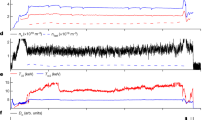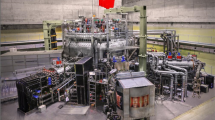Abstract
The current fusion energy development path, based on large volume moderate magnetic B field devices is proving to be slow and expensive. A modest development effort in exploiting new superconductor magnet technology development, and accompanying plasma physics research at high-B, could open up a viable and attractive path for fusion energy development. This path would feature smaller volume, fusion capable devices that could be built more quickly than low-to-moderate field designs based on conventional superconductors. Fusion’s worldwide development could be accelerated by using several small, flexible devices rather than relying solely on a single, very large device. These would be used to obtain the acknowledged science and technology knowledge necessary for fusion energy beyond achievement of high gain. Such a scenario would also permit the testing of multiple confinement configurations while distributing technical and scientific risk among smaller devices. Higher field and small size also allows operation away from well-known operational limits for plasma pressure, density and current. The advantages of this path have been long recognized—earlier US plans for burning plasma experiments (compact ignition tokamak, burning plasma experiment, fusion ignition research experiment) featured compact high-field designs, but these were necessarily pulsed due to the use of copper coils. Underpinning this new approach is the recent industrial maturity of high-temperature, high-field superconductor tapes that would offer a truly “game changing” opportunity for magnetic fusion when developed into large-scale coils. The superconductor tape form and higher operating temperatures also open up the possibility of demountable superconducting magnets in a fusion system, providing a modularity that vastly improves simplicity in the construction, maintenance, and upgrade of the coils and the internal nuclear engineering components required for fusion’s development. Our conclusion is that while tradeoffs exist in design choices, for example coil, cost and stress limits versus size, the potential physics and technology advantages of high-field superconductors are attractive and they should be vigorously pursued for magnetic fusion’s development.










Similar content being viewed by others
References
B.N. Sorbom, J. Ball, T.R. Palmer, F.J. Mangiarotti, J.M. Sierchio, P. Bonoli, C. Kasten, D.A. Sutherland, H.S. Barnard, C.B. Haakonsen, J. Goh, C. Sung, D.G. Whyte, Fusion Eng. Des. 100 (2014)
Gao report GAO-14-499 (2014)
V. Chan et al., Nucl. Fusion 51, 083019 (2011)
Y.K.M. Peng, Fusion Sci. Technol. 60(2), 441 (2011)
S.C. Jardin et al., Fusion Eng. Des. 48, 281 (2000)
J. Schmidt, J. Fusion Energy 10(4) (1991). doi:10.1007/BF01052124
D.M. Meade, Fusion Eng. Des. 63, 531 (2002)
T. Eich, A.W. Leonard, R.A. Pitts, W. Fundamenski, R.J. Goldston, T.K. Gray, A. Herrmann, A. Kirk, A. Kallenbach, O. Kardaun, A.S. Kukushkin, B. LaBombard, R. Maingi, M.A. Makowski, A. Scarabosio, B. Sieglin, J. Terry, A. Thornton, A.U. Team, J.E. Contributors, Nucl. Fusion 53, 9 (2013)
D.G. Whyte, B. LaBombard, J.W. Hughes, B. Lipschultz, J. Terry, D. Brunner, P.C. Stangeby, D. Elder, A.W. Leonard, J. Watkins, J. Nucl. Mater. 438, S435–S439 (2013)
B. LaBombard, FESAC-SP White Paper (2014); B. LaBombard, et al., Nucl. Fusion 55, 053020 (2015)
F. Najmabadi et al., Fusion Eng. Des. 80, 3 (2006)
Y.A. Podpaly, G.M. Olynyk, M.L. Garrett, P.T. Bonoli, D.G. Whyte, Fusion Eng. Des. 87, 3 (2012)
M. Greenwald, FESAC Report (2007)
J. Wei, W.G. Chen, W.Y. Wu et al., IEEE Trans. Appl. Supercond. 20 (2010). doi:10.1109/TASC.2010.2040030
K. Kim, H.K. Park, K.R. Park et al., Nucl. Fusion 45 (2005). doi:10.1088/0029-5515/45/8/003
S. Imagawa, S. Masuzaki, N. Yanagi, S. Yamaguichi, T. Satow, J. Yamamoto, O. Motojima, Fusion Eng. Des. 41 (1998). doi:10.1016/S0920-3796(97)00178-6
H.-S. Bosch, V. Erckmann, R.W.T. König, F. Schauer, R.J. Stadler, A. Werner, IEEE Trans. Plasma Sci. 38(3) (2010). doi:10.1109/TPS.2009.2036918
M.O. Hoenig, Y. Iwasa, D.B. Montgomery, IEEE Trans. Magn. MAG-11 2 (1975). doi:10.1109/TMAG.1975.1058601
U.P. Trociewitz, M. Dalban-Canassy, M. Hannion, D.K. Hilton, J. Jaroszynski, P. Noyes, Y. Viouchkov, H.W. Weijers, D.C. Larbalestier, Appl. Phys. Lett. 99, 202506 (2011)
L. Bromberg, M. Tekula, L.A. El-Guebaly, et al., Fusion Eng. Des. 54 (2001). doi:10.1016/S0920-3796(00)00432-4
G.M. Olynyk, et al., Fusion Eng. Des. 87 (2012). doi:10.1016/j.fusengdes.2011.12.009
F. Najmabadi, Fusion Technol. 30 (1996). doi:10.1109/IECEC.1996.561162
J.V. Minervini, J.H. Schultz, IEEE Trans. Appl. Supercond. 13 (2003). doi:10.1109/TASC.2003.812766
N. Martovetsky, P. Michael, J. Minervini, A. Radovinsky, M. Takayasu, R. Thome, T. Ando, T. Isono, T. Kato, H. Nakajima, G. Nishijima, Y. Nunoya, M. Sugimoto, Y. Takahashi, H. Tsuji, D. Bessette, K. Okuno, M. Ricci, IEEE Trans. Appl. Supercond. 11(1) (2001). doi:10.1109/77.920253
V. Selvamanickam, A. Xu, Y. Liu, N.D. Khatri, E. Galstyan, G. Majkic, C. Lei, Y. Chen, Supercond. Sci. Technol. 27, 055010 (2014)
B. Coppi, A. Airoldi, R. Albanese, G. Ambrosino, F. Bombarda, A. Bianchi, A. Cardinali, G. Cenacchi, E. Costa, P. Detragiache, G. De Tommasi, A. DeVellis, G. Faelli, A. Ferrari, A. Frattolillo, P. Frosi, F. Giammanco, G. Grasso, M. Lazzaretti, S. Mantovani, S. Migliori, S. Pierattini, A. Pironti, G. Ramogida, G. Rubinacci, M. Sassi, M. Tavani, A. Tumino, F. Villon, Nucl. Fusion 53, 104013 (2013)
M. Takayasu, L. Chiesa, L. Bromberg, J.V. Minervini, Supercond. Sci. Technol. 25(1) (2012). doi:10.1088/0953-2048/25/1/014011
L. Bromberg, J.V. Minervini, J.H. Schultz et al., IEEE Trans. Appl. Supercond. 22, 3 (2012)
S. Hahn et al. App. Phys. Lett 173511 (2013)
A. Garofalo, Phys. Plasmas 13, 056110 (2006)
E. Marmar, FESAC-SP White paper (2014)
R. Parker, FESAC-SP White paper (2014)
M.D. Larbalestier, A. Gurevich, D.M. Feldmann, A. Polyanskii, Nature 414 (2001). doi:10.1038/35104654
Author information
Authors and Affiliations
Corresponding author
Rights and permissions
About this article
Cite this article
Whyte, D.G., Minervini, J., LaBombard, B. et al. Smaller & Sooner: Exploiting High Magnetic Fields from New Superconductors for a More Attractive Fusion Energy Development Path. J Fusion Energ 35, 41–53 (2016). https://doi.org/10.1007/s10894-015-0050-1
Published:
Issue Date:
DOI: https://doi.org/10.1007/s10894-015-0050-1




